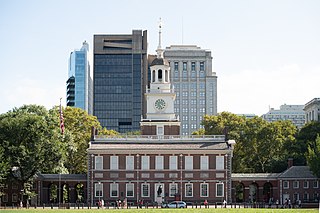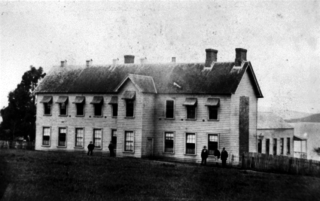Related Research Articles

The provinces of the Colony of New Zealand existed as a form of sub-national government. Initially established in 1846 when New Zealand was a Crown colony without responsible government, two provinces were first created. Each province had its own legislative council and governor. With the passing of the New Zealand Constitution Act 1852 the provinces were recreated around the six planned settlements or "colonies". By 1873 the number of provinces had increased to nine, but they had become less isolated from each other and demands for centralised government arose. In 1875 the New Zealand Parliament decided to abolish the provincial governments, and they came to an end in November 1876. They were superseded by counties, which were later replaced by territorial authorities.

The Quartering Acts were several acts of the Parliament of Great Britain which required local authorities in the Thirteen Colonies of British North America to provide British Army personnel in the colonies with housing and food. Each of the Quartering Acts was an amendment to the Mutiny Act and required annual renewal by Parliament. They were originally intended as a response to issues which arose during the French and Indian War and soon became a source of tensions between the inhabitants of the colonies and the government in London. These tensions would later lead toward the American War of Independence.

Independence Hall is a historic civic building in Philadelphia, where both the Declaration of Independence and the Constitution of the United States were debated and adopted by the Founding Fathers of the United States. The structure, which is the centerpiece of Independence National Historical Park, was designated a World Heritage Site in 1979.

The Pennsylvania Constitution of 1776 was the state's first constitution following its declaration of independence and has been described as the most democratic in America. It was drafted by Robert Whitehill, Timothy Matlack, Dr. Thomas Young, George Bryan, James Cannon, and Benjamin Franklin. Pennsylvania's innovative and highly democratic government structure, featuring a unicameral legislature and collective executive, may have influenced the later French Republic's formation under the French Constitution of 1793. The constitution also included a declaration of rights that coincided with the Virginia Declaration of Rights of 1776.

The Province of Pennsylvania, also known as the Pennsylvania Colony, was a British North American colony founded by William Penn, who received the land through a grant from Charles II of England in 1681. The name Pennsylvania was derived from "Penn's Woods", referring to William Penn's father Admiral Sir William Penn.

The Province of North Carolina, originally known as Albemarle Province, was a proprietary colony and later royal colony of Great Britain that existed in North America from 1712 to 1776.(p. 80) It was one of the five Southern colonies and one of the thirteen American colonies. The monarch of Great Britain was represented by the Governor of North Carolina, until the colonies declared independence on July 4, 1776.

The Province of Massachusetts Bay was a colony in New England which became one of the thirteen original states of the United States. It was chartered on October 7, 1691, by William III and Mary II, the joint monarchs of the kingdoms of England, Scotland, and Ireland, and was based in the merging of several earlier British colonies in New England. The charter took effect on May 14, 1692, and included the Massachusetts Bay Colony, the Plymouth Colony, the Province of Maine, Martha's Vineyard, Nantucket, Nova Scotia, and New Brunswick; the Commonwealth of Massachusetts is the direct successor. Maine has been a separate state since 1820, and Nova Scotia and New Brunswick are now Canadian provinces, having been part of the colony only until 1697.
Thomas Rudyard was a Quaker lawyer in London before moving to America and being appointed deputy governor of East Jersey and the first Attorney General of the English Province of New York, the predecessor position to the Attorney General of New York State and the successor position to an analogous office under the Dutch colonial government of New Netherlands.
Gawen Lawrie was a deputy governor of the American province of East Jersey from 1683 to 1686.

The Frame of Government of Pennsylvania was a proto-constitution for the Province of Pennsylvania, a proprietary colony granted to William Penn by Charles II of England. The Frame of Government has lasting historical importance as an important step in the development of American and world democracy.

The New Zealand Constitution Act 1846 was an Act of the Parliament of the United Kingdom intended to grant self-government to the Colony of New Zealand, but it was never fully implemented. The Act's long title was An Act to make further Provision for the Government of the New Zealand Islands, and it received the royal assent on 28 August 1846.

The North Carolina Provincial Congress was an extralegal representative assembly patterned after the colonial lower house that existed in North Carolina from 1774 to 1776. It led the transition from British provincial to U.S. state government in North Carolina. It established a revolutionary government, issued bills of credit to finance the provincial government, provided for the common defense, and adopted the state's first constitution.
The Provincial Congresses were extra-legal legislative bodies established in ten of the Thirteen Colonies early in the American Revolution. Some were referred to as congresses while others used different terms for a similar type body. These bodies were generally renamed or replaced with other bodies when the provinces declared themselves states.

The Massachusetts Provincial Congress (1774–1780) was a provisional government created in the Province of Massachusetts Bay early in the American Revolution. Based on the terms of the colonial charter, it exercised de facto control over the rebellious portions of the province, and after the British withdrawal from Boston in March 1776, the entire province. When Massachusetts Bay declared its independence in 1776, the Congress continued to govern under this arrangement for several years. Increasing calls for constitutional change led to a failed proposal for a constitution produced by the Congress in 1778, and then a successful constitutional convention that produced a constitution for the state in 1780. The Provincial Congress came to an end with elections in October 1780.

Patrick Gordon was Deputy governor of the Province of Pennsylvania and the Lower Counties on the Delaware from 22 June 1726 to 4 August 1736. He was deputy to the Proprietors of Pennsylvania, the heirs of William Penn, rather than to a governor. Since the proprietors were usually in England, he was essentially the governor.
His Majesty's Council for the Province of New Jersey was the upper house of the New Jersey Legislature under colonial rule until it was replaced by the New Jersey Legislative Council under the New Jersey Constitution of 1776.
Nicholas More was first chief justice of the colonial-era Province of Pennsylvania.

The East New Jersey Provincial Council or Governor's Council was the upper house of the East New Jersey Legislature under proprietary rule until the surrender of the right of government to The Crown, and Queen Anne's acceptance.

The General Assembly House, colloquially called "Shedifice" by the members of Parliament, was the first building to house the New Zealand Parliament in Auckland. It was in use by Parliament from 1854 until 1864 during the time that Auckland was the capital of New Zealand. It was also used by the Auckland Provincial Council, with Auckland Province owning the building from 1858. After the abolition of the provincial government system, the building was used by the government's survey department and was then used by Auckland University College. The General Assembly House was demolished in 1917 to make way for Anzac Avenue. Today, a reserve adjacent to Parliament Street called Parliament Reserve commemorates the location where the New Zealand Parliament met initially.
The Second North Carolina Provincial Congress was the second extra-legal unicameral body of the North Carolina Provincial Congress that met beginning in 1774. They were modeled after the colonial lower house. These congresses created a government structure, issued bills of credit to pay for the movement, and organized an army for defense, in preparation for the state of North Carolina. These congresses paved the way for the first meeting of the North Carolina General Assembly on April 7, 1777 in New Bern, North Carolina. The second Congress met in New Bern from April 3 to April 7, 1775.
References
- ↑ "Government Structure in Colonial Pennsylvania". Education.seattlepi.com. Retrieved 22 June 2019.